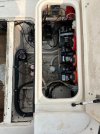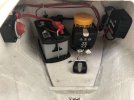- Joined
- Sep 26, 2009
- Messages
- 352
- Reaction score
- 111
- Points
- 43
- Location
- Massachusetts
- Model
- Express 330
Considering changing the battery configuration from the stock 330 set up with a 2 bank system. Reason: occasionally lose electronics when restarting an engine while fishing due to voltage drop. I'd like to have the confidence to shut motors off when offshore overnight.
Possible configuration is a 3 bank system; one battery dedicated to starting each motor, and a parallel pair for the house. This should provide more power for longer duration for running electronics.
One question I have - in the stock set up one bank is tied to the windlass, and the other is tied to the thruster. Those are the two largest draws if used. In reality, I've yet to use the windlass for anything other than testing it. Is there any risk in tying both of these to the house bank? Neither would be used without motors running.
There are at least two ways to ensure charging of the house bank. First is using the aux charging ability of the Yamaha's. Second is using an ACR. I'm very familiar with Blue Seas ACR, as I installed this on my last boat. I've not had the ability to have an aux charger previously.
Another question - if going the ACR route, it appears that the existing 2 bank charger can be used, as once either starting battery is up to 13.x volts, the house will be charged. This says that a new charger is not required. This seems to swing the choice towards the ACR, as the house bank will always be charged via the ACR, which is not true of using the aux charger from the motors - the house only charged if motors running. Am I understanding this correctly?
The costs appear similar for both options.
Possible configuration is a 3 bank system; one battery dedicated to starting each motor, and a parallel pair for the house. This should provide more power for longer duration for running electronics.
One question I have - in the stock set up one bank is tied to the windlass, and the other is tied to the thruster. Those are the two largest draws if used. In reality, I've yet to use the windlass for anything other than testing it. Is there any risk in tying both of these to the house bank? Neither would be used without motors running.
There are at least two ways to ensure charging of the house bank. First is using the aux charging ability of the Yamaha's. Second is using an ACR. I'm very familiar with Blue Seas ACR, as I installed this on my last boat. I've not had the ability to have an aux charger previously.
Another question - if going the ACR route, it appears that the existing 2 bank charger can be used, as once either starting battery is up to 13.x volts, the house will be charged. This says that a new charger is not required. This seems to swing the choice towards the ACR, as the house bank will always be charged via the ACR, which is not true of using the aux charger from the motors - the house only charged if motors running. Am I understanding this correctly?
The costs appear similar for both options.




